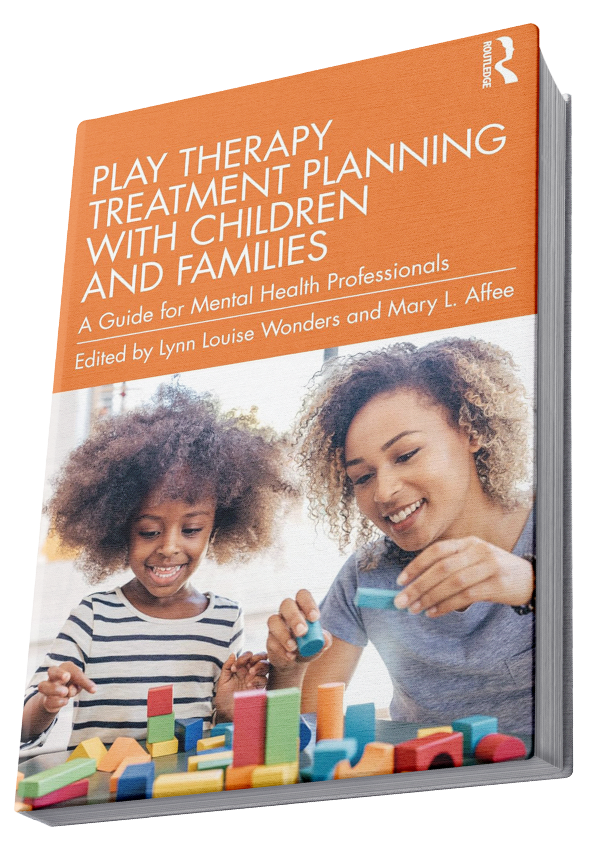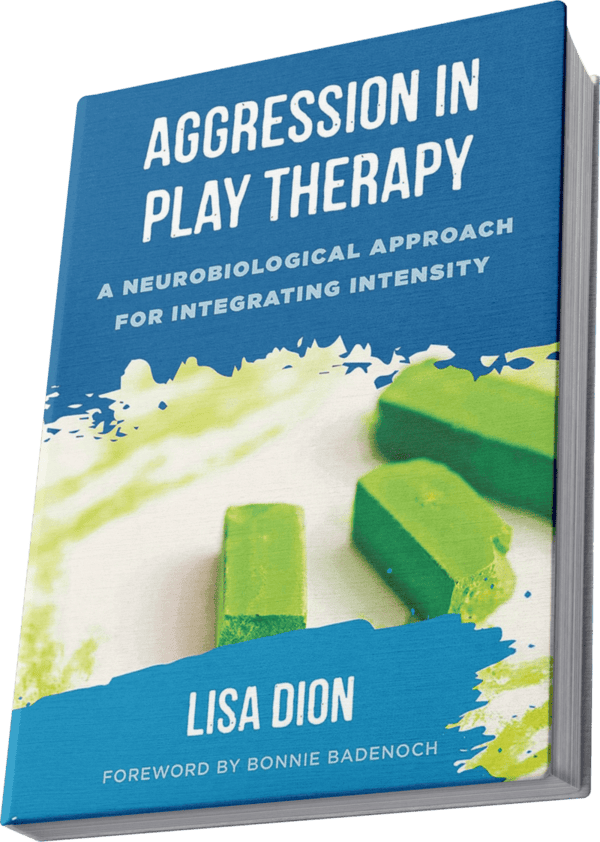Synergetic Play Therapy
Synergetic Play Therapy (SPT) is a research-informed model of play therapy that blends the therapeutic powers of play with principles from nervous system regulation, interpersonal neurobiology, attachment theory, physics, mindfulness, and therapist authenticity.
Synergetic Play Therapy®
Synergetic Play Therapy (SPT) is a research-informed model of play therapy that blends the therapeutic powers of play with principles from nervous system regulation, interpersonal neurobiology, attachment theory, physics, mindfulness, and therapist authenticity.

What is Synergetic Play Therapy?
Developed by Lisa Dion in 2008, SPT emerged from both clinical experience and key research in neuroscience, Interpersonal Neurobiology, and attachment theory (see Badenoch, 2008; Porges, 2011; Schore, 1994; Siegel, 1999). Preliminary research has shown that SPT can significantly enhance a child’s capacity for emotional regulation and tolerance (Dion & Gray, 2014; Simmons, 2020).
More than a model, SPT is a way of being in relationship with oneself and others. Its principles are universal and can be integrated with any existing therapeutic approach—or used as a foundational framework. SPT includes both directive and non-directive elements, allowing flexibility to meet the individual needs of the child and therapeutic context.
What Makes SPT Unique?
Incorporates directive and non-directive approaches
Applicable across the lifespan: children, teens, adults, families, and groups
Helps therapists manage aggression and dysregulation in the playroom
Focuses on the therapist’s own regulation and authenticity
Based on Synergetics: transformation through system interaction
Introduction to the Treatment Model
The term “Synergetics” (from physicist Buckminster Fuller) describes how systems transform through dynamic interaction. In the playroom, this principle is mirrored in the relational process between therapist and child. Healing happens not in isolation, but through a “synergy of systems” where internal and external regulation co-exist.
By first attuning to their own internal state and then to the child’s, the therapist creates a synergetic field where co-regulation becomes possible. Through this right-hemisphere-to-right-hemisphere communication, integration and transformation begin. New neural connections are formed, paving the way for lasting change (Dion & Gray, 2014).

SPT is built on three pillars:
- The therapeutic powers of play
- The science of relationships
- The development and authenticity of the therapist

The Philosophy of SPT
In SPT, the therapist is the most important toy in the playroom. The toys become tools to help:
The child explore their inner world and the challenges they’ve experienced
Deepen the connection between the child and the therapist
But in SPT’s truest form, toys and language aren’t required. What matters most is the emotional energy and the perceptions being expressed through play.
SPT views the therapist as an external regulator who helps the child stay within a window of tolerance as they explore challenging thoughts, feelings, and sensations. Just as a caregiver regulates an infant, the therapist leads the way—modeling authenticity, congruence, and presence.
Because over 60% of communication is non-verbal, it’s essential that the therapist’s verbal and non-verbal signals align. This alignment builds trust and safety, opening space for integration.
The Tenets of Synergetic Play Therapy
The following nine tenets support SPT therapists in understanding their role and guiding clients toward integration and regulation:
The child’s symptoms are understood as expressions of the activation of the autonomic nervous system.
The child projects his/her/their inner world onto the toys and the therapist, setting them up to experience his/her/their perception of what it feels like to be him/her/them.
The therapist’s ability to use mindfulness to attune to themselves and the child is an essential component for co-regulation.
The therapist becomes the external regulator modeling and co-regulating the child for integration and re-patterning of the activation of the autonomic nervous system.
The therapist’s ability to be congruent and authentic in language and non-verbal signals allows the child to feel safe in the relationship and engage in reflective awareness.
The therapist supports the child in integrating his/her/their perceptions of the perceived challenging events and thoughts in his/her/their lives.
The therapist supports the child in getting in touch with the child’s authentic self, who the child truly is rather than who the child thinks he/she/they should be.
The therapist is the most important toy in the playroom. In SPT, toys and language are not required.
The synergy between the therapist’s authenticity, attunement, congruence, and nervous system regulation support the child in learning how to attach to self, the cornerstone of all healing.
To track therapeutic progress, SPT integrates:
- The SPT Therapeutic Stages
- The SPT Process of Change
- Identification of the child’s starting points in treatment
These processes guide treatment planning, goal setting, and integration over time.
Learn more in A Synergetic Play Therapy Approach to Treatment Planning (Wonders & Affee, 2024)

Training & Certification Pathway
SPT is taught across multiple platforms, including the Lessons from the Playroom Podcast, blogs, YouTube videos, and formal courses. Certification is available for both licensed mental health professionals and non-clinicians.
Prerequisite: Must be working with children or have prior experience doing so. Those seeking CE credit must be enrolled in or have completed graduate-level mental health training (or equivalent in their country).

Level 1: Introduction to Synergetic Play Therapy
- 30+ hour program | Online or In-Person
- Includes live learning, recorded content, group consultation
- Topics: foundational tenets, projective process, regulation, attunement, emotional flooding, caregiver involvement, and more
- Cost includes 13 consultation sessions (10 individual and 3 group)
Level 2: Certified Synergetic Play Therapy Program
- 85+ hour program | Online only
- Includes recorded sessions, homework, consultation, skill evaluation
- Topics: deepening of Level 1 content, trauma storage, physics and emotions, directive and non-directive play, working with various populations, and so much more
- Cost includes 6 group consultation sessions


Level 3: Certified Synergetic Play Therapy Supervisor Program
- 30+ hour program | Online
- Focus on supervision through the lens of SPT, ethics, reflective practice, cultural opportunity
- Cost includes consultation sessions
Recertification Requirements
Strengths of SPT
SPT can serve as either a foundational play therapy framework or be layered into an existing one. Its principles apply beyond children—extending to teens, adults, groups, and families.
SPT centers therapist authenticity, self-regulation, and congruence, supporting both therapist and client transformation. This emphasis reduces compassion fatigue and vicarious trauma while preparing therapists to hold intensity in the playroom, including aggression and dysregulation.
Training also includes:
- Navigating the intake and treatment planning process
- Setting goals and tracking progress
- Translating the child’s play into meaningful language for caregivers
- Supporting termination and integration


Why Therapists Love SPT
- ✨ Integrates easily into any existing play therapy approach
- ✨ Applies across age groups, including teens and adults
- ✨ Equips therapists to manage high-intensity and dysregulation
- ✨ Emphasizes authenticity, regulation, and congruence
- ✨ Supports therapist transformation and reduces burnout

Scope of Practice & Population Considerations
While SPT tenets are broadly applicable, Level 1 focuses on children ages 4–11. Therapist readiness and ethical scope are emphasized, and parental involvement is often a vital component.
For more complex family systems, therapists may require additional training. SPT therapists are encouraged to continue consultation with Certified SPT Supervisors to responsibly integrate the model across diverse populations and challenges.
Who Thrives in This Model
- Value authenticity, attunement, and embodiment
- Are open to self-reflection and personal growth
- Embrace the integration of neuroscience, physiology, biology, physics, mindfulness, attachment, and psychology
- Embrace the nuances of trauma and interpersonal neurobiology
- Prefer a flexible, process-based approach over rigid frameworks
SPT is not well suited for those looking for a primarily cognitive modality of play therapy. It calls for presence, creativity, curiosity, and a desire to evolve alongside one’s clients.


Publications & Research
The Synergetic Play Therapy Institute collaborates with the SPT Foundation and academic partners to conduct and publish research. Explore the Publications section for access to peer-reviewed articles, book chapters, and books.
The heart of Synergetic Play Therapy lies in the synergy between therapist and child—a relational field where nervous system regulation, authentic connection, and co-regulation pave the way for transformation. When the therapist becomes the external regulator, children can access and move through challenging internal experiences in ways that are safe and reparative.
This synergy not only supports the healing of the child but also fosters integration for the therapist—bringing both into deeper connection with themselves and others.
